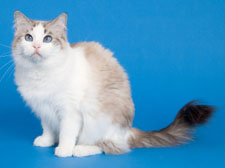|
The Scratching Post
Ragdoll 
The Ragdoll is a medium to large well-balanced cat. The head is large with a broad, modified wedge-shape. The medium-sized ears are moderately flared, wide at the base, rounded at the tips and tilted forward. The sparkling, vivid blue eyes are wide set and slightly slanted. The neck is strong and heavy. The chest is full and the large body is long, broad and solid. They have short legs and the paws are very large, round and have feathering. The tail is long and has a full plume. The natural, non-matting coat comes in four patterns: bi-color, van, mitted and colorpoint.
|
|
Temperament
|
The Ragdoll is docile and sweet. This playful breed will agree to just about any suggestion and adapt easily to most environments. They get along great with adults and dogs. They are an ideal pet for young children as they will tolerate and appreciate lots of hugs and kisses and can withstand a young child?s exploration and behavior towards them. This breed is easily trained, mild-mannered and people-oriented. Ragdolls have a soft, pleasant voice and will chat in a polite voice if they have something to say.
|
|
Weight
|
Male 12-20 lbs. ; Female 8-15 lbs.
|
|
Health Problems
|
Because of their large size, this breed may be prone to hip dysplasia. A minor concern with this breed is the inherited heart disease feline hypertrophic cardiomyopathy (HCM).
|
|
Living Conditions
|
Ragdolls make great apartment cats. These non-aggressive cats cannot and should not be let outside for prolonged periods as many may not be able to defend themselves and most do not hunt. A protected environment is your cat?s safest recourse.
|
|
Exercise
|
Cats receive valuable exercise from playing. Playing builds the bond that you share as well as burns calories, releases aggression and burns off excess energy in younger cats. It is also important to have a sturdy scratching post accessible for your Ragdoll.
|
|
Life Expectancy
|
About 15-25 years
|
|
Grooming
|
Ragdolls require regular grooming to prevent matting of the fur and to give them an overall fluffy and healthy appearance. A good weekly grooming with a steel comb will remove loose hairs and keep the Ragdoll?s coat looking best. Extra attention should be given to the hindquarters during grooming since the coat is longer there.
|
|
Origin
|
Ragdolls were created in the 1960?s by Riverside, California breeder Ann Baker. Baker bred, what was believed to be, a white female Persian-type cat to a Seal Point Birman. One of the male offspring from this breeding was then bred to a Burmese. This began the foundation for the Ragdoll. In 1971, Baker founded her own registry called the International Ragdoll Cat Association (IRCA) in an attempt to protect her proprietary interests and to keep control of the breed. Baker?s stronghold on the breed?s name led to displeasure from other Ragdoll owners. In 1975, the dissatisfied breeders split from Baker and the IRCA and formed the Ragdoll Society which was later changed to the Ragdoll Fanciers? Club International (RFCI). The RFCI was founded by Denny and Laura Dayton and was dedicated to developing the breed and achieving recognition with the mainstream cat associations. The Ragdoll was granted championship by the CFA in 2000. The name Ragdoll derived from the fact that many of these cats go completely limp and relax when picked up.
|